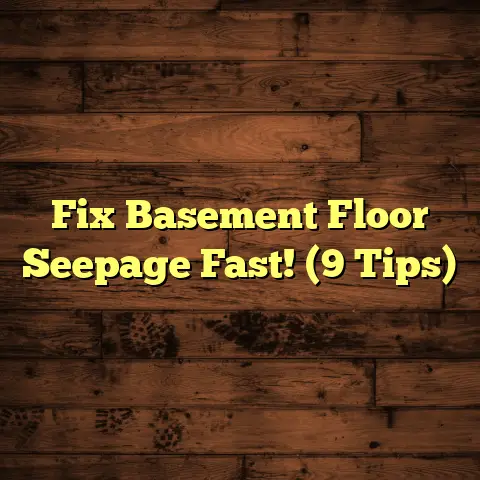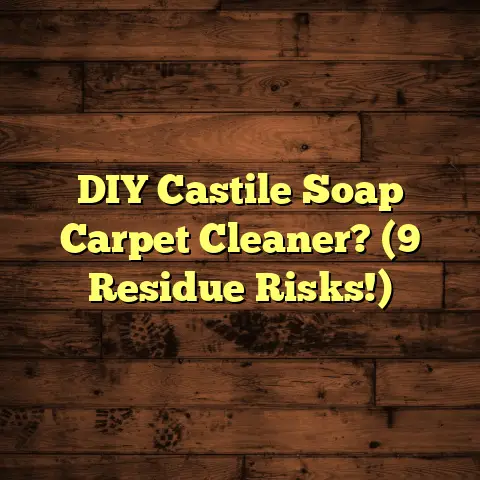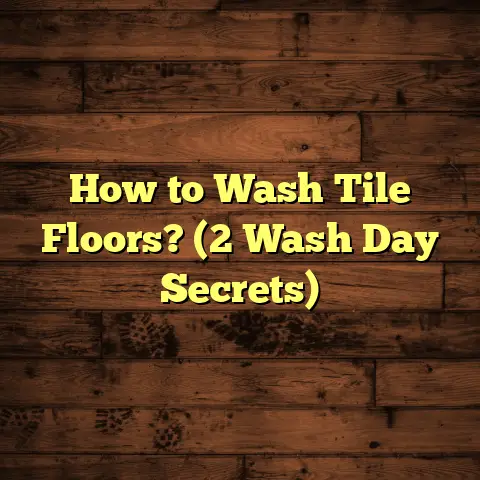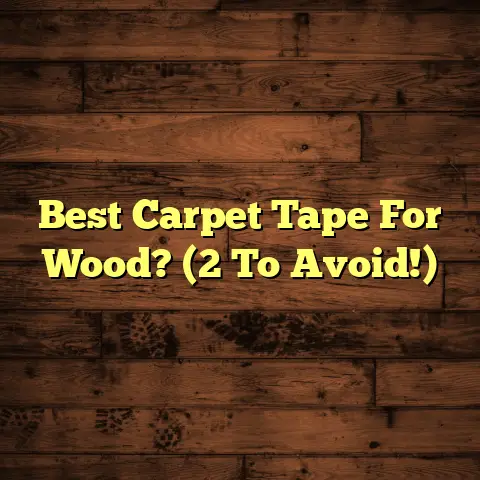Stop Garage Floor Efflorescence (1 Easy Fix!)
One Easy Fix for a Sustainable Solution
You know, home improvement isn’t just about the latest trends or adding value to your property. It’s also about making choices that are good for our planet.
Sustainable practices in home care are a win-win: they help our environment and make our living spaces last longer and function better.
Let’s talk about something that might be bugging you: efflorescence on your garage floor.
That white, powdery stuff isn’t just ugly; it’s a sign of moisture problems that can lead to serious damage.
That’s where I come in! I’m here to tell you that by tackling efflorescence the right way – with sustainable methods – you can protect your garage and do your part for a greener planet.
My goal today is to show you an easy fix that will keep your garage floor looking great and your conscience clear. Sound good? Let’s dive in!
Section 1: Understanding Efflorescence
Okay, so what exactly is efflorescence? Simply put, it’s that white, crystalline deposit you often see on concrete or brick surfaces, especially in garages.
Think of it like this: concrete and masonry materials contain soluble salts. When water seeps into these materials, it dissolves those salts.
Then, as the water evaporates, it leaves the salts behind on the surface, creating that powdery residue. It’s like the concrete is “sweating” out its salts!
This is a chemical process that looks like this: Water + Soluble Salts (inside concrete) → Salt Solution → Evaporation → Efflorescence (salt deposit)
Several environmental factors contribute to efflorescence. Here are some of the most common:
-
Climate: Areas with high humidity or frequent rainfall are more prone to efflorescence because there’s more water available to dissolve the salts.
-
Groundwater: If your garage floor is in contact with damp soil, groundwater can wick up through the concrete, bringing salts along for the ride.
-
Construction Materials: Some concrete mixes contain higher levels of soluble salts than others, making them more susceptible to efflorescence.
It’s not just cosmetic, folks. If you ignore efflorescence, it can lead to some serious problems down the road.
Here’s what can happen:
-
Structural Damage: Over time, the repeated dissolving and crystallizing of salts can weaken the concrete, leading to cracks and crumbling.
-
Constant Repairs: Addressing the underlying moisture issues and repairing the damage caused by efflorescence can be costly and time-consuming.
-
Environmental Tax: Constantly repairing and replacing materials is resource-intensive and generates waste.
I’ve seen garages where the efflorescence was so bad, the concrete was literally disintegrating. It’s a costly mess to fix!
Section 2: The Importance of Addressing Efflorescence
Let’s get real: ignoring efflorescence is like ignoring a leaky faucet. It might seem like a small problem at first, but it can quickly turn into a major headache.
Here’s what happens when you let efflorescence run wild:
-
Flooring Deterioration: The constant moisture and salt buildup can damage epoxy coatings, sealants, and other flooring materials, causing them to peel, crack, or bubble.
-
Health Risks: Trapped moisture creates the perfect breeding ground for mold and mildew, which can trigger allergies, asthma, and other respiratory problems.
-
Economic Impact: Neglecting efflorescence leads to increased maintenance costs, the need for frequent repairs, and eventually, the expensive replacement of flooring materials.
I remember one client who ignored the efflorescence in his garage for years. He thought it was just a minor cosmetic issue.
Big mistake! By the time he called me, the moisture had damaged the concrete so badly that he had to replace the entire floor. Ouch!
Addressing efflorescence isn’t just about aesthetics; it’s about creating a more sustainable living environment.
Here’s how:
-
Reduced Chemical Treatments: By preventing moisture from entering the concrete, you can avoid the need for harsh chemical cleaners and sealants.
-
Less Waste: Addressing the problem early prevents further damage, reducing the need for costly repairs and replacements.
-
Healthier Home: By preventing mold and mildew growth, you can improve indoor air quality and create a healthier living space for your family.
According to the EPA, indoor air quality can be two to five times more polluted than outdoor air. EPA Indoor Air Quality
Addressing moisture problems like efflorescence is a crucial step in creating a healthier indoor environment.
Section 3: Sustainable Practices for Preventing Efflorescence
Okay, now that we know why efflorescence is bad news, let’s talk about how to prevent it from happening in the first place.
The key is to focus on sustainable building materials and practices that minimize moisture intrusion.
Here are some tips:
-
Eco-Friendly Sealants: Choose sealants that are low in VOCs (volatile organic compounds) and made from sustainable materials. These sealants create a barrier that prevents water from penetrating the concrete. I recommend looking for water-based acrylic sealants that are breathable to allow moisture vapor to escape.
-
Moisture Barriers: Install a moisture barrier under your concrete slab to prevent groundwater from wicking up through the concrete. Polyethylene sheeting is a common and effective option.
-
Permeable Materials: Consider using permeable paving materials around your garage to allow rainwater to drain away from the foundation. Gravel, pavers with gaps, or porous concrete are all good choices.
Proper drainage and landscaping are also essential for preventing moisture problems.
Here’s what you should do:
-
Grading: Make sure the ground around your garage slopes away from the foundation to direct water away.
-
Gutters and Downspouts: Keep your gutters clean and ensure that downspouts are directing water away from the foundation.
-
Landscaping: Avoid planting shrubs or trees too close to the foundation, as they can trap moisture.
Regular maintenance and inspections are also crucial for preventing efflorescence.
Make it a habit to:
-
Inspect: Check your garage floor regularly for signs of efflorescence, cracks, or other damage.
-
Clean: Clean up any spills or standing water promptly.
-
Seal: Reapply sealant every few years to maintain a protective barrier against moisture.
I always tell my clients that prevention is the best medicine. By taking these steps, you can significantly reduce the risk of efflorescence and keep your garage floor looking great for years to come.
Section 4: The Easy Fix: Addressing Efflorescence
Alright, let’s get to the good stuff: the easy fix for stopping garage floor efflorescence!
I’m going to share a method that I’ve used successfully with countless clients, and it’s both effective and sustainable.
The key is to use a natural, eco-friendly sealant.
For this, I recommend using a Silicate-based concrete sealer. Silicate sealers react with the concrete to form a permanent, waterproof barrier.
Why I like Silicate-based sealers: * Penetrating: They penetrate deep into the concrete pores. * Breathable: They allow moisture vapor to escape, preventing pressure buildup. * Durable: They create a long-lasting, chemically resistant surface. * Eco-Friendly: They are water-based and have low VOC content.
Here’s a step-by-step guide to implementing this fix:
Step 1: Preparation
- Clear the Area: Remove everything from your garage floor.
- Clean the Floor: Thoroughly clean the floor with a stiff brush and a solution of water and mild detergent. Rinse well and allow to dry completely.
- Remove Efflorescence: Use a wire brush or a concrete scraper to remove any existing efflorescence. You can also use a solution of vinegar and water (1:1 ratio) to help dissolve the salts. Be sure to rinse thoroughly and let the floor dry completely.
Step 2: Application
- Apply the Sealant: Using a pump sprayer or a roller, apply a thin, even coat of the silicate-based concrete sealer to the floor. Follow the manufacturer’s instructions for application rates and drying times.
- Second Coat (Optional): For added protection, you can apply a second coat of sealant after the first coat has dried completely.
Step 3: Finishing Touches
- Curing: Allow the sealant to cure for the recommended time (usually 24-48 hours) before walking or driving on the floor.
- Maintenance: Regularly sweep or mop the floor to remove dirt and debris. Avoid using harsh chemicals or abrasive cleaners, as they can damage the sealant.
Tips for Best Results:
- Test First: Before applying the sealant to the entire floor, test it in a small, inconspicuous area to ensure compatibility and desired results.
- Follow Instructions: Always follow the manufacturer’s instructions for application rates, drying times, and safety precautions.
- Ventilation: Ensure adequate ventilation during application and curing.
- Temperature: Apply the sealant when the temperature is between 50°F and 90°F (10°C and 32°C) for best results.
I’ve seen this simple fix transform garage floors from eyesores to beautiful, durable surfaces. And the best part is, it’s a sustainable solution that’s good for the environment!
The long-term benefits of this fix are:
-
Reduced Maintenance: The sealant creates a protective barrier that prevents moisture from penetrating the concrete, reducing the need for frequent cleaning and repairs.
-
Enhanced Durability: The sealant strengthens the concrete, making it more resistant to wear and tear, chemicals, and stains.
-
Improved Indoor Air Quality: By preventing moisture from entering the concrete, you can reduce the risk of mold and mildew growth, improving indoor air quality.
-
Cost Savings: By preventing damage and reducing maintenance, you can save money in the long run.
Section 5: Real-Life Case Studies
Let me share a couple of stories about homeowners who successfully implemented this easy fix for efflorescence in their garages.
Case Study 1: The Smith Family
The Smiths had been battling efflorescence in their garage for years. They tried various chemical cleaners and sealants, but nothing seemed to work for long.
The efflorescence kept coming back, and their garage floor looked terrible.
I recommended they try the silicate-based concrete sealer. They were skeptical at first, but they decided to give it a try.
They followed the steps I outlined above, and the results were amazing! The efflorescence disappeared, and their garage floor looked brand new.
They were so happy with the results that they decided to seal their driveway and patio as well.
Here’s what Mrs. Smith said: “We were so frustrated with the efflorescence in our garage. We tried everything, but nothing seemed to work. Our garage floor looks amazing, and we feel good knowing that we’re using a sustainable solution.”
Case Study 2: John’s Garage Makeover
John was renovating his garage and wanted to create a clean, modern space. But he was concerned about the efflorescence on the floor.
I suggested he use the silicate-based concrete sealer as part of his renovation project. He followed my advice, and the results were stunning.
The sealant not only prevented efflorescence but also enhanced the appearance of the concrete floor.
John was so pleased with the results that he decided to use sustainable materials throughout his entire garage renovation.
“I wanted to create a garage that was not only beautiful but also environmentally friendly,” John told me. It’s effective, sustainable, and it looks great!”
These case studies demonstrate that addressing efflorescence with sustainable methods is not only possible but also highly effective.
By making conscious choices about the materials we use and the practices we follow, we can create homes that are both beautiful and environmentally responsible.
Here are some ways these homeowners’ decisions made a positive environmental impact:
-
Reduced Chemical Usage: By using a natural sealant, they avoided the need for harsh chemical cleaners and sealants.
-
Lower Resource Consumption: By preventing damage to the concrete, they reduced the need for costly repairs and replacements.
-
Healthier Environment: By preventing mold and mildew growth, they improved indoor air quality and created a healthier living space.
Conclusion
So, there you have it: an easy, sustainable fix for stopping garage floor efflorescence.
Remember, addressing efflorescence isn’t just about aesthetics; it’s a crucial component of sustainable home maintenance.
By preventing moisture intrusion and protecting your concrete, you can create a healthier, more durable, and environmentally friendly home.
I encourage you to adopt sustainable practices in your homes. Small, manageable steps can lead to significant environmental benefits.
By addressing garage floor efflorescence with the easy fix I’ve shared today, you can contribute to a healthier planet while enjoying a beautiful and functional garage space.
It’s a win-win!





